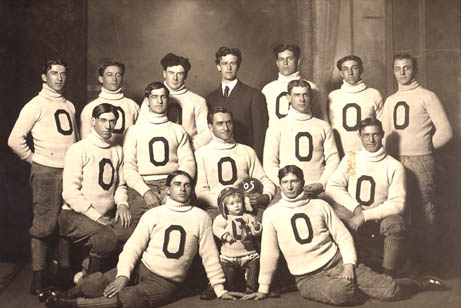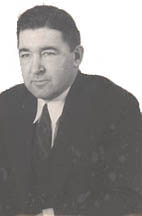![]()
Football has survived the most difficult years in history. Through WWI and the Great Depression, football continued. During WWII, football was not played for two years at Oshkosh State Teachers College, but it came back in full force.
The first football season for Oshkosh Normal School was in 1894. In this year, the players organized their own team and the competition. In the three games the Oshkosh Normals played that year, two of the games were victories.
Throughout the years, the football team has been housed in many different places, including the fairgrounds, Menominee Park, the Memorial Stadium on New York, and the Jackson Street Athletic Field.

Men's football team, 1905-1906

Oshkosh Normal home game, ca. 1930s
Early competition for Oshkosh included Ripon, Milwaukee, Lawrence, Whitewater, River Falls, and La Crosse. Trains were probably used for transportation between cities. Oshkosh experienced success in the early years. The roster of the football team was small: 11 in 1899; 16 in 1910; and 18 in 1920. Athletes played both offence and defense, there was limited substitution in the game, and there were no special teams for the kickoff. In 1920, the Normalites won the state championship.
Before 1905, kickoff could be dangerous. Receiving teams were allowed to form a flying wedge where the players would meet and lock arms, destroying the opposition. The kickoff team would have "wedge busters" who would sacrifice their bodies to break the flying wedge. People were dying because of this technique, which was one of the many reasons for the birth of the NCAA. President Teddy Roosevelt wanted the corruption and injuries in college sports to end, so he established a governing body that would enforce universal rules. This eliminated "ringers" and stopped the "flying wedge".
In 1921, Oshkosh hired Coach Howard Hancock who also become the athletic director. Hancock also created a coaching staff by hiring two assistants. His coaching success is demonstrated by championships in 1923 and 1928, and a tie for the championship with River Falls in 1925. In 25 conference games from 1921 to 1925 Oshkosh was 17 - 4 - 4. In 1921 and 1922, Oshkosh placed second in the conference, which consisted of six teams: Oshkosh, Superior, Whitewater, Stevens Point, Platteville, and Milwaukee. Non-conference play included Ripon, St John's Military Academy, Lawrence, and Marquette. In 1930, the first night game was played against Platteville.
In 1931, Robert Kolf was hired as the head coach Kolf was an alumni and a past football player. During his 31 years at Oshkosh, the team roster grew and ranged from 30 to 50 players. He implemented two weeks of practice time to get players ready for their first game. In his fourth year at Oshkosh, Kolf led his team to an undefeated championship season.

Coach Robert Kolf
Football at Oshkosh State Teachers College was not greatly affected by the Depression. The team had yet to purchase practice equipment, but there was enough money to outfit the team with pads and uniforms and travel to and from the games. Harry Gorwitz, who was a team manager during the Depression, said there was never any chance of football being cut because of financial difficulties. It was just too important to the school.
Interscholastic football was not played in 1942 and 1943 because of WWII. There were fewer than 20 men remaining on campus, and Kolf also entered the service. Kolf returned to Oshkosh for the 1946 season. A major highlight of Kolf's 31-year coaching career was beating Stevens Point in the 1960 season, since Oshkosh had not defeated them on their field for 30 years.
Equipment continued to improve as years went by. Plastic helmets were introduced and pads were changed from heavy leather and wool to a lighter plastic and foam construction. The introduction of the facemask saved many broken noses and teeth.
In 1963 Russ Young was hired. He was an excellent recruiter and in his 13 years at Oshkosh, he never cut a player. Young loved Oshkosh football so much that his last wish was to have his ashes scattered over Titan Stadium. His defensive coordinator and future coach of the Titans, Dave Hochtritt, fulfilled this wish. Hochtritt referred to Coach Young as his second father.
Young's career at Oshkosh included winning three conference championships in 1968, 1972, and 1976. In both 1968 and 1976, the championship was shared with Whitewater. In the 1968 season, during a game with Platteville, a drunk driver hit a streetlight and blacked out the city. There was still one play left in the third quarter when this occurred, but the game could not be completed. The decision was made to play one quarter plus one play when the season was over. Platteville won this game. The loss created a tie for the championship between Oshkosh and Whitewater. Had Oshkosh won the Platteville game, the championship would have been theirs.
In 1969 Oshkosh scheduled four games with Division I teams. They were Eastern Michigan, Weber State, Eastern Kentucky, and the University of Tampa. Oshkosh played Eastern Michigan tight until the fourth quarter, but lost to the team that would become national champions that year. Oshkosh also played the University of Tampa at Tampa Stadium in front of 50,000 fans; they lost 56 - zero.
Titan Stadium was built in 1971. It had a superior press box and nice locker rooms. When it was finished, crowds in excess of 10,000 would come to the football games. Practice fields were located next to the stadium.
In 1977 Oshkosh hired Dave Hochtritt, who had been the defensive coordinator for 10 years, as the new head coach. He was the first coach to start his career with the aid of an athletic trainer. A major highlight in his career was when CBS wanted to televise a Sunday afternoon game during the 1982 NFL strike season. On Sunday October 3, 1982, the Titans played UW Stout. Stout was ranked fourth in Division III. Tim Ryan and John Morris, CBS announcers for the Chicago Bears, called the game. Oshkosh jumped out to a 7 - 0 lead in the first quarter and went into halftime with a 7-6 lead, but in the end, they lost 23 - 15.
Improvements continued in football equipment. Facemasks were expanded into the birdcage style. Pads were lighter and made with cantilever construction; this took the blow off of players' shoulders and distributed it throughout the body.
Four athletes from Oshkosh who played for Young and Hochtritt became professional players. Ron Cardo played one preseason with the San Francisco 49ers; Myles Strasser and Dave Kanas both played for the Canadian Football League with the Montreal Alouettes; and John Dettmann played for the Green Bay Packers.
In 1984, Ron Cardo was hired as head coach at Oshkosh. He was a dominant player for Oshkosh in the 1970s. He is the first coach in the history of football at Oshkosh who is strictly a football coach. The other coaches taught 12 - 15 credits during the football season. In the 100 years of college football history, there have been championship years and lean years. Thus is the story of college football.
References
Advance Titan. (1982 fall isues).
Gorwitz, Harry. (1999). Personal interview on the history of football at The University of Wisconsin Oshkosh.
Hochtritt, Dave. (1999). Personal interview on the history of football at The University of Wisconsin Oshkosh.
The Quiver. (1897-1971). The University of Wisconsin Oshkosh Yearbook.
